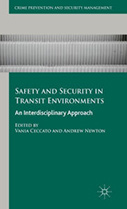Safety and Security in Transit Environments: An Interdisciplinary Approach

Editors: Vania Ceccato and Andrew Newton
Publisher: Houndmills, Basingstoke, Hampshire, UK; New York: Palgrave Macmillan, 2015. 390p.
Reviewer: Brandon Kooi | May 2016
Safety and Security in Transit Environments is an intentional effort to bring together multiple disciplines from criminology, transport, architecture, urban planning/civil engineering, psychology, communications, and geography. The book includes multiple authors and is divided into 5 sections (summarized below), with 20 chapters written by transit security specialists from the United States, United Kingdom, Norway, Sweden, Italy, Japan, Australia, and South Africa. The structure of the book begins with a generalized introduction to safety and security in transit systems and follows four ![]() structured parts- 1) crime at transit hubs (micro settings); 2) transit journeys; 3) links to the surrounding environments (meso and macro settings); and 4) users’ perspectives. In these sections, key challenges are identified along with various policy implications for transit crime prevention.
structured parts- 1) crime at transit hubs (micro settings); 2) transit journeys; 3) links to the surrounding environments (meso and macro settings); and 4) users’ perspectives. In these sections, key challenges are identified along with various policy implications for transit crime prevention.
Section 1 introduces safety and security in transit environments with two chapters written by the editors, Caccato and Newton. The authors provide the theoretical framework for studying transit security and note the international comparative use of public transit. For example, approximately 25% of households in the UK and Sweden do not own a car, and are thus reliant on public transit. Their reliance is often dictated by safety concerns at public transit stops, during specific times and even throughout the journey. Place-based theories (i.e., environmental criminology and crime science) provide the foundation for understanding public transit safety and security. The book offers what is believed to be the first volume dedicated to international crime and safety concerns in public transit.
Section 2 contains four chapters with a focus on transport nodes and the micro environment of transit systems. “Nodes” represent convergence points along the transit network where people and goods are ![]() transferred. These locations (narrowly and widely conceptualized in the literature) can become criminogenic as identified through routine activities theory, where offenders converge on suitable targets in locations that lack capable guardianship. Additional theories discussed here include crime pattern theory and rational choice. These opportunity theories provide support for understanding cellular phone thefts on Boston subways, and also strategies for improving guardianship in the
transferred. These locations (narrowly and widely conceptualized in the literature) can become criminogenic as identified through routine activities theory, where offenders converge on suitable targets in locations that lack capable guardianship. Additional theories discussed here include crime pattern theory and rational choice. These opportunity theories provide support for understanding cellular phone thefts on Boston subways, and also strategies for improving guardianship in the
Stockholm and London transit systems. Further, commercial establishments located in the proximity of bus stops are linked to high incidents of pickpocketing and other crimes as compared to other urban settings that are not near a bus stop. Limitations from the research are noted, since bus stop locations are frequently near numerous commercial properties, subway systems, etc., creating some concerns about spurious findings. In addition, crime data are frequently imprecise with regard to exact locations.
Section 3 focuses on the journey of crime and when individuals move into unfamiliar environments that pose risks. Transit locations throughout their journey may be crowded and lack capable guardians, thus facilitating criminal activities. Interestingly, the use of cell phones improves the chances crimes will be reported, but also creates additional targets for theft. Three chapters here describe the journey of crime. Units of analysis include the Hudson-Bergen Light Rail in New Jersey, the Space-Time Adolescent Risk Study on Violence reported by Philadelphia youth regarding their daily activities outside their home, and a mock-bus stop laboratory set-up through University College in London.
Section 4 looks at the meso and macro ecological settings of transit systems in urban environments through six chapters. The focus of this section is on how local environments impact safety and security in public transportation, and how the transport network impacts neighborhoods. For example, one chapter details how robberies at transit stations in the Bronx, New York were more frequent in the afternoon hours when located near schools, and in the evening when located near drinking establishments. Violent assaults were more likely around transit located near parks. Research on bus stops in Henderson, Nevada indicated that bus stops experience higher amounts of crime when they are linked with specific activity nodes (e.g., ATMs).
Section 5 focuses on transit users’ perceptions of safety, with four chapters detailing research from Japan, the United States, Scandinavia, Italy and Sweden. Perspectives are drawn from crime and disorder issues with an interesting focus on females and visually impaired transit users. These chapters discuss the importance of matching security needs and policies based upon transit users’ perspectives and specialized needs. Surveys, interviews, and focus groups can be enormously beneficial for gathering proper analytical data, so transit security planners can provide adequate responses to identified problems.
The last chapter of the book, written by the editors, synthesizes the findings and provides challenges for future research endeavors with respect to safety in public transit. Safety and security in public transit is challenging and complex. The five sections of this book provide the conceptual framework for addressing these challenges. Nevertheless, some limitations with the framework presented are also pointed out. These limitations include the inability to differentiate regional/national transit security, the need for developing theories that are not dependent on the immediate context of the system characteristics (i.e., bus vs. railway or offense types), and the need to better understand safety throughout the entirety of the journey via public transit. Finally, several policy implications include enhancing security at nodes through improvements in access control, natural surveillance, and official guardianship. These recommendations require cooperation among stakeholders who consider long-term risk assessment and take account of the whole experience of the transit journey.
Brandon Kooi, Associate Professor of Criminal Justice, Aurora University


